Ecological Connectivity in Agricultural Green Infrastructure: Suggested Criteria for Fine Scale Assessment and Planning
Abstract
:1. Introduction
2. Materials and Methods
2.1. Study Area
2.2. Research Design
2.3. First Step: Definition of GI Components According to Target Species, Ecosystem Occurrence, and Naturalness
2.4. Second Step: Detection of Current Connectivity
- Level 1—Areal components, with both high and low degree of naturalness;
- Level 2—Both areal and linear components, with all degrees of naturalness;
- Level 3—Areal components with just a high degree of naturalness;
- Level 4—Both areal and linear components with just a high degree of naturalness.
2.5. Third Step: Prioritization of Conservation and Restoration Measures
- (a)
- Node Importance [47], calculated as
- (b)
- Condition of the EUN of occurrence, derived from the previous methodological step and qualitatively scored, with a null value assigned to the less critical EUNs and a unit value assigned to the most critical one.
- (c)
- Link Removal indicator, so that the removal of each bridge was simulated, the respective impact (dIIC) calculated as for nodes, and the priority quantitatively scored according to distribution of the indicator values into quartiles;
- (d)
- Conservation priority of the nodes connected by the link, derived from Node Importance (criterion a) and qualitatively scored in compliance with every emerging combination (i.e., the higher the importance of nodes, the higher the score assigned to the connector);
- (e)
- Connection importance, assigned to links that, if removed, originate a new component;
- (f)
- Structural contiguity and singularity of connections, so that a higher priority was assigned to bridges and branches with respect to isolated islets (due to less contiguity) and to loops (due to connection redundancy).
3. Results
3.1. Current GI Components
- areal “Natural-high”, including Oak woods with Quercus cerris and locally with Q. virgiliana or Q robur (map code 3112); Hygrophilous woods with Populus sp.pl., Salix sp.pl., Alnus glutinosa and Fraxinus oxycarpa (3116); Shrublands with Prunus spinosa, Rubus ulmifolius, Spartium junceum and/or Pteridium aquilinum (3222); and Tall herbaceous and woody vegetation of ditches and wetlands (3223);
- areal “Natural-low”, including Non-native broad-leaved woods with Robinia pseudoacacia and/or Ailanthus altissima (3117); Broad-leaved forest plantations 3118); and Mediterranean pine or cypress forest plantations (3121);
- linear “Natural”, when dominated by spontaneous woody species;
- linear “Artificial”, when dominated by planted woody species.
3.2. Current Ecological Connectivity
3.3. Conservation Priorities
3.4. Restoration Priorities
4. Discussion
4.1. Strength and Weakness of Target Species Selection
4.2. Strength and Weakness of Connectivity Assessment
4.3. Strength and Weakness of Prioritization Procedure
5. Conclusions
Supplementary Materials
Author Contributions
Funding
Data Availability Statement
Acknowledgments
Conflicts of Interest
Abbreviations
References
- Baguette, M.; Blanchet, S.; Legrand, D.; Stevens, V.M.; Turlure, C. Individual dispersal, landscape connectivity and ecological networks. Biol. Rev. 2013, 88, 310–326. [Google Scholar] [CrossRef]
- Wang, Z.; Wang, Z.; Zhang, B.; Lu, C.; Ren, C. Impact of land use/land cover changes on ecosystem services in the Nenjiang River Basin, Northeast China. Ecol. Proc. 2015, 4, 11. [Google Scholar] [CrossRef] [Green Version]
- Honeck, E.; Moilanen, A.; Guinaudeau, B.; Wyler, N.; Schlaepfer, M.A.; Martin, P.; Sanguet, A.; Urbina, L.; von Arx, B.; Massy, J.; et al. Implementing Green Infrastructure for the Spatial Planning of Peri-Urban Areas in Geneva, Switzerland. Sustainability 2020, 12, 1387. [Google Scholar] [CrossRef] [Green Version]
- Zhang, Z.; Sara, M.; Newell, J.; Lindquist, M. Enhancing Landscape Connectivity through Multi-functional Green Infrastructure Corridor Modeling and Design. Urban For. Urban Green. 2019, 38, 305–317. [Google Scholar] [CrossRef]
- Bennett, A.F.; Radford, J.Q.; Haslem, A. Properties of land mosaics: Implications for nature conservation in agricultural environments. Biol. Conserv. 2006, 133, 250–264. [Google Scholar] [CrossRef]
- La Point, S.; Balkenhol, N.; Hale, J.; Sadler, J.; van der Ree, R. Ecological connectivity research in urban areas. Funct. Ecol. 2015, 29, 868–878. [Google Scholar] [CrossRef]
- Carlier, J.; Moran, J. Hedgerow typology and condition analysis to inform greenway design in rural landscapes. J. Environ. Manag. 2019, 247, 790–803. [Google Scholar] [CrossRef] [PubMed]
- La Rosa, D.; Barbarossa, L.; Privitera, R.; Martinico, F. Agriculture and the city: A method for sustainable planning of new forms of agriculture in urban contexts. Land Use Policy 2014, 41, 290–303. [Google Scholar] [CrossRef]
- Ochoa, C.Y.; Jiménez, D.F.; Olmo, R.M. Green Infrastructure Planning in Metropolitan Regions to Improve the Connectivity of Agricultural Landscapes and Food Security. Land 2020, 9, 414. [Google Scholar] [CrossRef]
- Zeller, A.K.; Lewsion, R.; Fletcher, J.R.; Tulbure, G.M.; Jennings, M. Understanding the Importance of Dynamic Landscape Connectivity. Land 2020, 9, 303. [Google Scholar] [CrossRef]
- De Blois, S.; Domon, G.; Bouchard, A. Landscape issues in plant ecology. Ecography 2002, 25, 244–256. [Google Scholar] [CrossRef]
- Godfree, R.; Firn, J.; Johnson, S.; Knerr, N.; Stol, J.; Doerr, V. Why non-native grasses pose a critical emerging threat to biodiversity conservation, habitat connectivity and agricultural production in multifunctional rural landscapes. Landsc. Ecol. 2020, 32, 1219–1242. [Google Scholar] [CrossRef] [Green Version]
- Uroy, L.; Ernoult, A.; Mony, C. Effect of landscape connectivity on plant communities: A review of response patterns. Landsc. Ecol. 2020, 34, 203–225. [Google Scholar] [CrossRef]
- Damschen, E.I.; Brudvig, L.A.; Burt, M.A.; Fletcher, R.J.; Haddad, N.M.; Levey, D.J.; Orrock, J.L.; Resasco, J.; Tewksbury, J.J. Ongoing accumulation of plant diversity through habitat connectivity in an 18-year experiment. Science 2019, 365, 1478–1480. [Google Scholar] [CrossRef]
- Schleicher, A.; Biedermann, R.; Kleyer, M. Dispersal traits determine plant response to habitat connectivity in an urban landscape. Landsc. Ecol. 2011, 26, 529–540. [Google Scholar] [CrossRef]
- Thiele, J.; Kellner, S.; Buchholz, S.; Schirmel, J. Connectivity or area: What drives plant species richness in habitat corridors? Landsc. Ecol. 2018, 33, 173–181. [Google Scholar] [CrossRef]
- EC (European Commission). Communication from the Commission to the European Parliament, the Council, the European Economic and Social Committee and the Committee of the Regions ‘Green Infrastructure (GI)—Enhancing Europe’s Natural Capital’. 2013. Available online: http://eur-lex.europa.eu/resource.html?uri=cellar:d41348f2-01d5-4abe-b817-4c73e6f1b2df.0014.03/DOC_1&format=PDF (accessed on 3 May 2021).
- Ferrari, G.; Bocci, E.; Lepisto, E.; Cavallero, P.; Rombai, L. Territories and Landscapes: Place Identity, Quality of Life and Psychological Well-Being in Rural Areas. In Italian Studies on Quality of Life, Social Indicators Research Series; Bianco, A., Conigliaro, P., Gnaldi, M., Eds.; Springer: Cham, Switzerland, 2019; pp. 287–305. [Google Scholar]
- Rescia, A.J.; Willaarts, B.A.; Schmitz, M.F.; Aguilera, P.A. Changes in land uses and management in two Nature Reserves in Spain: Evaluating the social–ecological resilience of cultural landscapes. Landsc. Urban. Plan. 2010, 98, 26–35. [Google Scholar] [CrossRef]
- Blasi, C.; Capotorti, G.; Copiz, R.; Guida, D.; Mollo, B.; Smiraglia, D.; Zavattero, L. Classification and mapping of the ecoregions of Italy. Plant. Biosyst. 2014, 148, 1255–1345. [Google Scholar] [CrossRef]
- Blasi, C.; Canini, L.; Capotorti, G.; Celesti, L.; Del Moro, M.A.; Ercole, S.; Filesi, L.; Fiorini, S.; Lattanzi, E.; Leoni, G.; et al. Flora vegetazione ed ecologia del paesaggio delle aree protette di RomaNatura. Inf. Bot. Ital. 2001, 33, 14–18. [Google Scholar]
- Cavallo, A.; Di Donato, B.; Guadagno, R.; Marino, D. Cities, agriculture and changing landscapes in urban milieu: The case of Rome. Rivista di Studi sulla Sostenibilità 2015, 1, 79–97. [Google Scholar] [CrossRef]
- Egidi, G.; Halbac-Cotoara-Zamfir, R.; Cividino, S.; Quaranta, G.; Salvati, L.; Colantoni, A. Rural in town: Traditional agriculture, population trends, and long-term urban expansion in metropolitan rome. Land 2020, 9, 53. [Google Scholar] [CrossRef] [Green Version]
- Salvati, L.; Munafo, M.; Morelli, V.G.; Sabbi, A. Low-density settlements and land use changes in a Mediterranean urban region. Landsc. Urban Plan. 2012, 105, 43–52. [Google Scholar] [CrossRef]
- Frondoni, R.; Mollo, B.; Capotorti, G. A landscape analysis of land cover change in the Municipality of Rome (Italy): Spatio-temporal characteristics and ecological implications of land cover transitions from 1954 to 2001. Landsc. Urban Plan. 2011, 100, 117–128. [Google Scholar] [CrossRef]
- Zavattero, L.; Frondoni, R.; Capotorti, G.; Copiz, R.; Blasi, C. Towards the identification and mapping of traditional agricultural landscapes at the national scale: An inventory approach from Italy. Landsc. Res. 2021. [Google Scholar] [CrossRef]
- Blasi, C.; Zavattero, L.; Marignani, M.; Smiraglia, D.; Copiz, R.; Rosati, L.; Del Vico, E. The concept of land ecological network and its design using a land unit approach. Plant. Biosyst. 2008, 142, 540–549. [Google Scholar] [CrossRef]
- Capotorti, G.; De Lazzari, V.; Alós Ortí, M. Local Scale Prioritisation of Green Infrastructure for Enhancing Biodiversity in Peri-Urban Agroecosystems: A Multi-Step Process Applied in the Metropolitan City of Rome (Italy). Sustainability 2019, 11, 3322. [Google Scholar] [CrossRef] [Green Version]
- Andreasen, J.K.; O’Neill, R.V.; Noss, R.; Slosser, N.C. Considerations for the development of a terrestrial index of ecological integrity. Ecol. Indic. 2001, 1, 21–35. [Google Scholar] [CrossRef]
- Ferrari, C.; Pezzi, G.; Diani, L.; Corazza, M. Evaluating Landscape Quality with Vegetation Naturalness Maps: An Index and Some Inferences. Appl. Veg. Sci. 2008, 11, 243–250. [Google Scholar] [CrossRef]
- Farris, E.; Filibeck, G.; Marignani, M.; Rosati, L. The power of potential natural vegetation (and of spatial-temporal scale), a response to Carrión & Fernández (2009). J. Biogeogr. 2010, 37, 2211–2213. [Google Scholar]
- Bennett, A.F. Linkages in the Landscape: The Role of Corridors and Connectivity in Wildlife Conservation; International Union for Conservation of Nature and Natural Resources: Cambridge, UK, 1999. [Google Scholar]
- Calabrese, J.M.; Fagan, W.F. A comparison-shopper’s guide to connectivity metrics. Front. Ecol. Environ. 2004, 2, 529–536. [Google Scholar] [CrossRef]
- Capotorti, G.; Del Vico, E.; Anzellotti, I.; Celesti-Grapow, L. Combining the Conservation of Biodiversity with the Provision of Ecosystem Services in Urban Green Infrastructure Planning: Critical Features Arising from a Case Study in the Metropolitan Area of Rome. Sustainability 2017, 9, 10. [Google Scholar] [CrossRef] [Green Version]
- Den Ouden, J.; Jansen, P.A.; Smit, R. Jays, mice and oaks: Predation and dispersal of Quercus robur and Q. petraea in north-western Europe. In Seed Fate: Predation, Dispersal and Seedling Establishment; Forget, P.M., Lambert, J.E., Hulme, P.E., van der Wall, S.B., Eds.; CABI Publishing: Wallingford, UK, 2005; pp. 223–240. [Google Scholar]
- Sarrocco, S.; Battisti, C.; Brunelli, M.; Calvario, E.; Ianniello, L.; Sorace, A.; Tefofili, C.; Trotta, M.; Visentin, M.; Marco, E.; et al. L’avifauna delle aree naturali protette del comune di Roma gestite dall’ente romanatura. Alula IX 2002, 9, 3–31. [Google Scholar]
- Capizzi, D.; Mortelliti, A.; Amori, G.; Colangelo, P.; Rondinini, C. I Mammiferi del Lazio. Distribuzione, Ecologia e Conservazione; Edizioni ARP: Rome, Italy, 2012; 266p. [Google Scholar]
- Sunyer, P.; Muñoz, A.; Bonal, R.; Espelta, J.M. The ecology of seed dispersal by small rodents: A role for predator and conspecific scents. Funct. Ecol. 2013, 27, 1313–1321. [Google Scholar] [CrossRef]
- Perea, R.; San Miguel, A.; Gil, L. Acorn dispersal by rodents: The importance of re-dispersal and distance to shelter. Basic Appl. Ecol. 2011, 12, 432–439. [Google Scholar] [CrossRef]
- CIRBFEP (Centro di Ricerca Interuniversitario Biodiversità, Fitosociologia ed Ecologia del Paesaggio). Carta della Vegetazione reale della Provincia di Roma. 2013. Available online: http://websit.cittametropolitanaroma.it/BDV2014/Veget_Reale.aspx (accessed on 18 May 2021).
- High Resolution Layers—Copernicus Land Monitoring Service. 2018. Available online: https://land.copernicus.eu/pan-european/high-resolution-layers/forests (accessed on 3 May 2021).
- Capotorti, G.; Alós Ortí, M.M.; Anzellotti, I.; Azzella, M.M.; Copiz, R.; Mollo, B.; Zavattero, L. The MAES process in Italy: Contribution of vegetation science to implementation of European Biodiversity Strategy to 2020. Plant. Biosyst. 2015, 149, 949–953. [Google Scholar] [CrossRef]
- Soille, P.; Vogt, P. Morphological segmentation of binary patterns. Pattern Recognit. Lett. 2009, 30, 456–459. [Google Scholar] [CrossRef]
- Saura, S.; Pascual-Hortal, L. A new habitat availability index to integrate connectivity in landscape conservation planning: Comparison with existing indices and application to a case study. Landsc. Urban Plan. 2007, 83, 91–103. [Google Scholar] [CrossRef]
- Saura, S.; Vogt, P.; Velázquez, J.; Hernando, A.; Tejera, R. Key structural forest connectors can be identified by combining landscape spatial pattern and network analyses. For. Ecol. Manag. 2011, 262, 150–160. [Google Scholar] [CrossRef]
- Pascual-Hortal, L.; Saura, S. Integrating landscape connectivity in broad-scale forest planning through a new graph-based habitat availability methodology: Application to capercaillie (Tetrao urogallus) in Catalonia (NE Spain). Eur. J. For. Res. 2006, 127, 23–31. [Google Scholar] [CrossRef]
- Saura, S.; Torné, J. Conefor 2.6 User Manual. 2012. Available online: http://www.conefor.org/files/usuarios/Manual_Conefor_26.pdf (accessed on 3 May 2021).
- Kendall, M.G. A New Measure of Rank Correlation. Biometrika 1938, 30, 81–93. [Google Scholar] [CrossRef]
- Benayas, J.M.R.; Altamirano, A.; Miranda, A.; Catalán, G.; Prado, M.; Lisón, F.; Bullock, J.M. Landscape restoration in a mixed agricultural-forest catchment: Planning a buffer strip and hedgerow network in a Chilean biodiversity hotspot. Ambio 2020, 49, 310–323. [Google Scholar] [CrossRef] [PubMed] [Green Version]
- Brussaard, L.; Caron, P.; Campbell, B.; Lipper, L.; Mainka, S.; Rabbinge, R.; Babin, D.; Pulleman, M. Reconciling biodiversity conservation and food security: Scientific challenges for a new agriculture. Curr. Opin. Environ. Sustain. 2010, 2, 34–42. [Google Scholar] [CrossRef]
- Van der Zanden, E.H.; Verburg, P.H.; Mucher, C.A. Modelling the spatial distribution of linear landscape elements in Europe. Ecol. Indic. 2013, 27, 125–136. [Google Scholar] [CrossRef]
- Blasi, C.; Capotorti, G.; Marchese, M.; Marta, M.; Bologna, M.A.; Bombi, P.; Bonaiuto, M.; Bonnes, M.; Carrus, G.; Cifelli, F.; et al. Interdisciplinary research for the proposal of the Urban Biosphere Reserve of Rome Municipality. Plant Biosyst. 2008, 142, 305–312. [Google Scholar] [CrossRef]
- Capotorti, G.; Bonacquisti, S.; Abis, L.; Aloisi, I.; Attorre, F.; Bacaro, G.; Balletto, G.; Banfi, E.; Barni, E.; Bartoli, F.; et al. More nature in the city. Plant Biosyst. 2020, 154, 1003–1006. [Google Scholar] [CrossRef]
- Rodríguez, J.C.; Sabogal, C. Restoring Degraded Forest Land with Native Tree Species: The Experience of “Bosques Amazónicos” in Ucayali, Peru. Forests 2019, 10, 851. [Google Scholar] [CrossRef] [Green Version]
- Bolliger, J.; Silbernagel, J. Contribution of connectivity assessments to Green Infrastructure (GI). ISPRS Int. J. Geo-Inf. 2020, 9, 212. [Google Scholar] [CrossRef] [Green Version]
- Scherr, S.J.; McNeely, J.A. Biodiversity conservation and agricultural sustainability: Towards a new paradigm of “ecoagriculture” landscapes. Philos. Trans. R. Soc. B Biol. Sci. 2008, 363, 477–494. [Google Scholar] [CrossRef] [Green Version]
- Ozinga, W.A.; Schaminée, J.H.J. Target species—Species of European concern; A database driven selection of plant and animal species for the implementation of the Pan European Ecological Network. In Alterra-Report; Alterra Wageningen UR: Wageningen, The Netherlands, 2005; Volume 1119. [Google Scholar]
- Rousset, O.; Lepart, J. Shrub facilitation of Quercus. humilis regeneration in succession on calcareous grasslands. J. Veg. Sci. 1999, 10, 493–502. [Google Scholar] [CrossRef]
- Smit, C.; Vandenberghe, C.; Ouden, J.D.; Müller-Schärer, H. Nurse plants, tree saplings and grazing pressure: Changes in facilitation along a biotic environmental gradient. Oecologia 2007, 152, 265–273. [Google Scholar] [CrossRef] [PubMed]
- Muñoz, M.R.; Squeo, F.A.; León, M.F.; Tracol, Y.; Gutiérrez, J.R. Hydraulic lift in three shrub species from the Chilean coastal desert. J. Arid Environ. 2008, 72, 624–632. [Google Scholar] [CrossRef]
- Pulido, F.; McCreary, D.; Cañellas, I.; McClaran, M.; Plieninger, T. Oak Regeneration: Ecological Dynamics and Restoration Techniques. In Mediterranean Oak Woodland Working Landscapes: Dehesas of Spain and Ranchlands of California; Campos, P., Huntsinger, L., Oviedo, J.L., Starrs, P.F., Diaz, M., Standiford, R.B., Montero, G., Eds.; Springer: New York, NY, USA, 2013; Volume 16, pp. 123–144. [Google Scholar]
- Chardon, J.P.; Adriaensen, F.; Matthysen, E. Incorporating landscape elements into a connectivity measure: A case study for the Speckled wood butterfly (Pararge aegeria L.). Landsc. Ecol. 2003, 18, 561–573. [Google Scholar] [CrossRef]
- León, M.C.; Harvey, C.A. Live fences and landscape connectivity in a neotropical agricultural landscape. Agrofor. Syst. 2006, 68, 15–26. [Google Scholar] [CrossRef]
- Thiele, J.; Schirmel, J.; Buchholz, S. Effectiveness of corridors varies among phytosociological plant groups and dispersal syndromes. PLoS ONE 2018, 13, e0199980. [Google Scholar] [CrossRef] [Green Version]
- Krosby, M.; Breckheimer, I.; Pierce, D.J.; Singleton, P.H.; Hall, S.A.; Halupka, K.C.; Gaines, W.L.; Long, R.A.; McRae, B.H.; Cosentino, B.L.; et al. Focal species and landscape “naturalness” corridor models offer complementary approaches for connectivity conservation planning. Landsc. Ecol. 2015, 30, 2121–2132. [Google Scholar] [CrossRef]
- Cao, Y.; Yang, R.; Carver, S. Linking wilderness mapping and connectivity modelling: A methodological framework for wildland network planning. Biol. Conserv. 2020, 251, 108679. [Google Scholar] [CrossRef]
- Lenoir, J.; Decocq, G.; Spicher, F.; Gallet-Moron, E.; Buridant, J.; Closset-Kopp, D. Historical continuity and spatial connectivity ensure hedgerows are effective corridors for forest plants: Evidence from the species–time–area relationship. J. Veg. Sci. 2021, 32, e12845. [Google Scholar] [CrossRef]
- Hu, T.; Chang, J.; Liu, X.; Feng, S. Integrated methods for determining restoration priorities of coal mining subsidence areas based on green infrastructure: A case study in the Xuzhou urban area of China. Ecol. Indic. 2018, 94, 164–174. [Google Scholar] [CrossRef]
- Norton, B.A.; Coutts, A.M.; Livesley, S.J.; Harris, R.J.; Hunter, A.M.; Williams, N.S. Planning for cooler cities: A framework to prioritise green infrastructure to mitigate high temperatures in urban landscapes. Landsc. Urban Plan. 2015, 134, 127–138. [Google Scholar] [CrossRef]
- García-Feced, C.; Saura, S.; Elena-Rosselló, R. Improving landscape connectivity in forest districts: A two-stage process for prioritizing agricultural patches for reforestation. For. Ecol. Manag. 2011, 261, 154–161. [Google Scholar] [CrossRef]
- Mimet, A.; Houset, T.; Julliard, R.; Simon, L. Assessing functional connectivity: A landscape approach for handling multiple ecological requirements. Methods Ecol. Evol. 2013, 4, 453–463. [Google Scholar] [CrossRef]
- Aavik, T.; Holderegger, R.; Bolliger, J. The structural and functional connectivity of the grassland plant Lychnis flos-cuculi. Heredity 2014, 112, 471–478. [Google Scholar] [CrossRef] [PubMed] [Green Version]
- Cui, N.; Feng, C.-C.; Wang, D.; Li, J.; Guo, L. The Effects of Rapid Urbanization on Forest Landscape Connectivity in Zhuhai City, China. Sustainability 2018, 10, 3381. [Google Scholar] [CrossRef] [Green Version]
- Devi, B.S.; Murthy, M.S.R.; Debnath, B.; Jha, C.S. Forest patch connectivity diagnostics and prioritization using graph theory. Ecol. Model. 2013, 251, 279–287. [Google Scholar] [CrossRef]
- Hernando, A.; Velázquez, J.; Valbuena, R.; Legrand, M.; García-Abril, A. Influence of the resolution of forest cover maps in evaluating fragmentation and connectivity to assess habitat conservation status. Ecol. Indic. 2017, 79, 295–302. [Google Scholar] [CrossRef]
- Gutiérrez-Chacón, C.; Valderrama-A, C.; Klein, A.M. Biological corridors as important habitat structures for maintaining bees in a tropical fragmented landscape. J. Insect Conserv. 2020, 24, 187–197. [Google Scholar] [CrossRef]
- Ascensão, F.; Santos-Reis, J.F.M. Highway verges as habitat providers for small mammals in agrosilvopastoral environments. Biodivers. Conserv. 2012, 21, 3681–3697. [Google Scholar] [CrossRef] [Green Version]
- Benayas, J.M.R.; Bullock, J.M.; Newton, A.C. Creating woodland islets to reconcile ecological restoration, conservation and agricultural land use. Front. Ecol. Environ. 2008, 6, 329–336. [Google Scholar] [CrossRef] [Green Version]
- Mikkonen, N.; Moilanen, A. Identification of top priority areas and management landscapes from a national natura 2000 network. Environ. Sci. Policy 2013, 27, 11–20. [Google Scholar] [CrossRef] [Green Version]
- Wolff, J.O.; Sherman, P.W. Rodent Societies: An. Ecological and Evolutionary Perspective; University of Chicago Press: Chicago, IL, USA, 2008. [Google Scholar]
- Ouin, A.; Paillat, G.; Butet, A.; Burel, F. Spatial dynamics of wood mouse (Apodemus sylvaticus) in an agricultural landscape under intensive use in the Mont Saint Michel Bay (France). Agric. Ecosyst. Environ. 2000, 78, 159–165. [Google Scholar] [CrossRef]
- Dondina, O.; Saura, S.; Bani, L.; Mateo-Sánchez, M.C. Enhancing connectivity in agroecosystems: Focus on the best existing corridors or on new pathways? Landsc. Ecol. 2018, 33, 1741–1756. [Google Scholar] [CrossRef]
- Lee, J.A.; Chon, J.; Ahn, C. Planning landscape corridors in ecological infrastructure using least-cost path methods based on the value of ecosystem services. Sustainability 2014, 6, 7564–7585. [Google Scholar] [CrossRef] [Green Version]
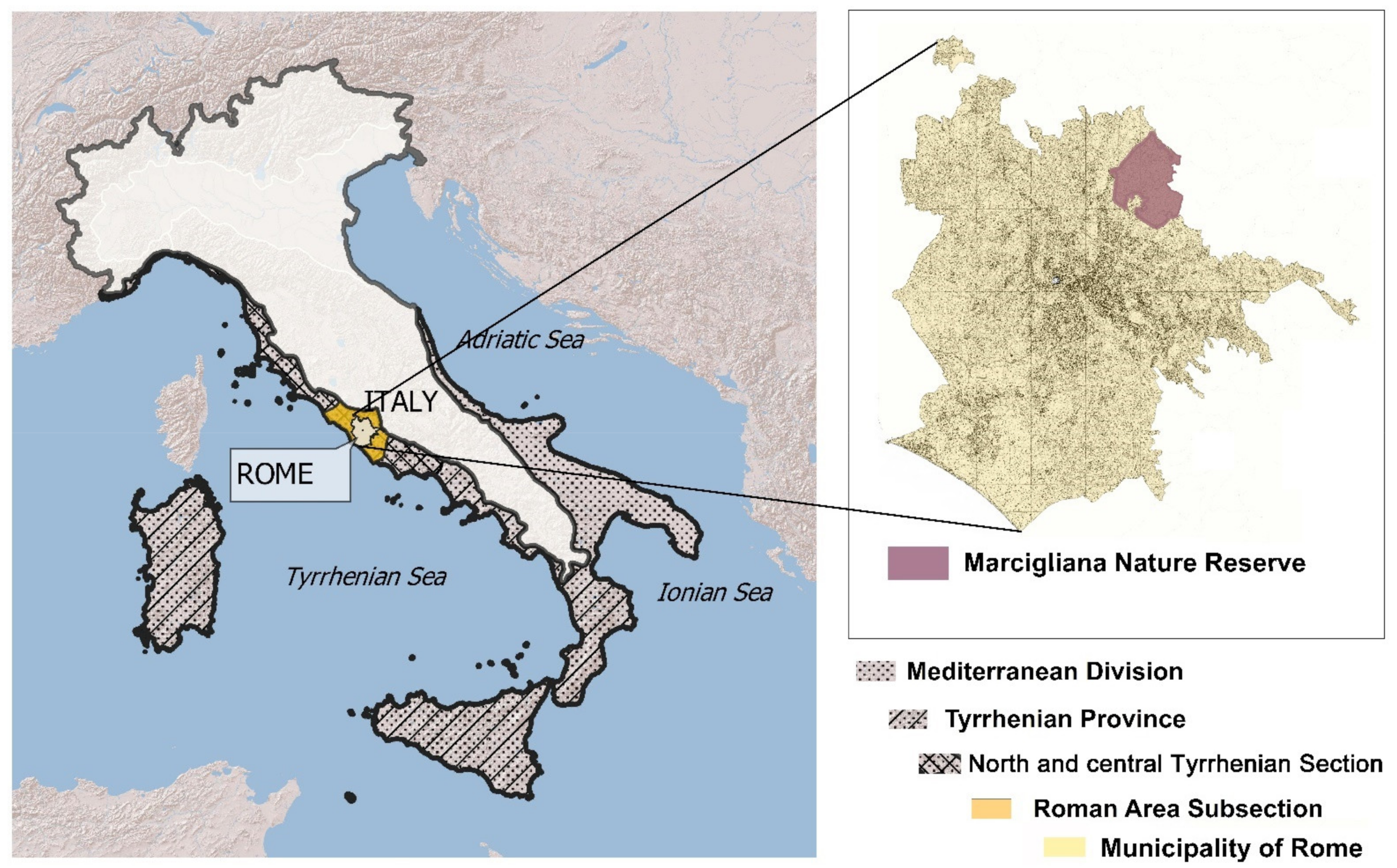

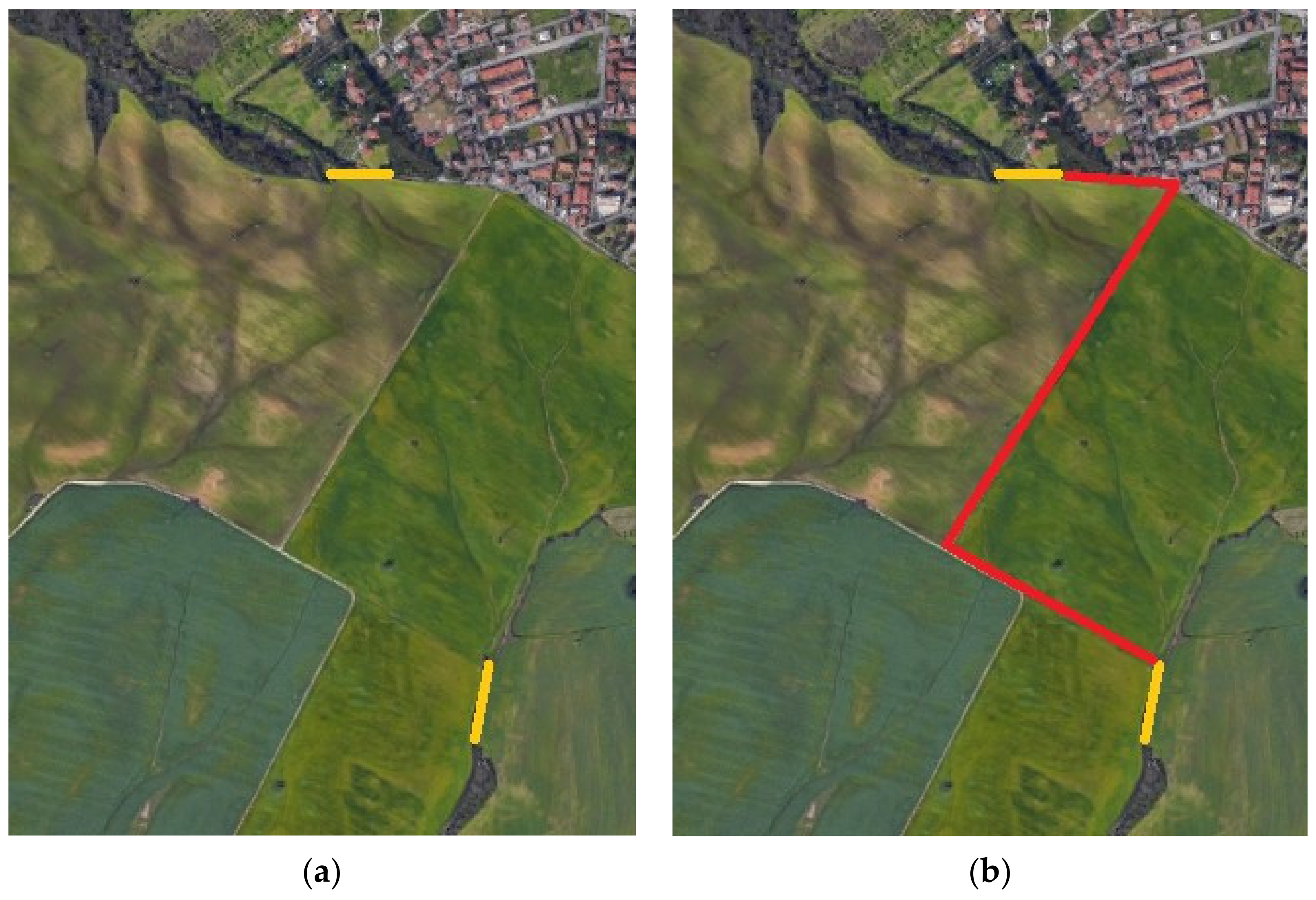
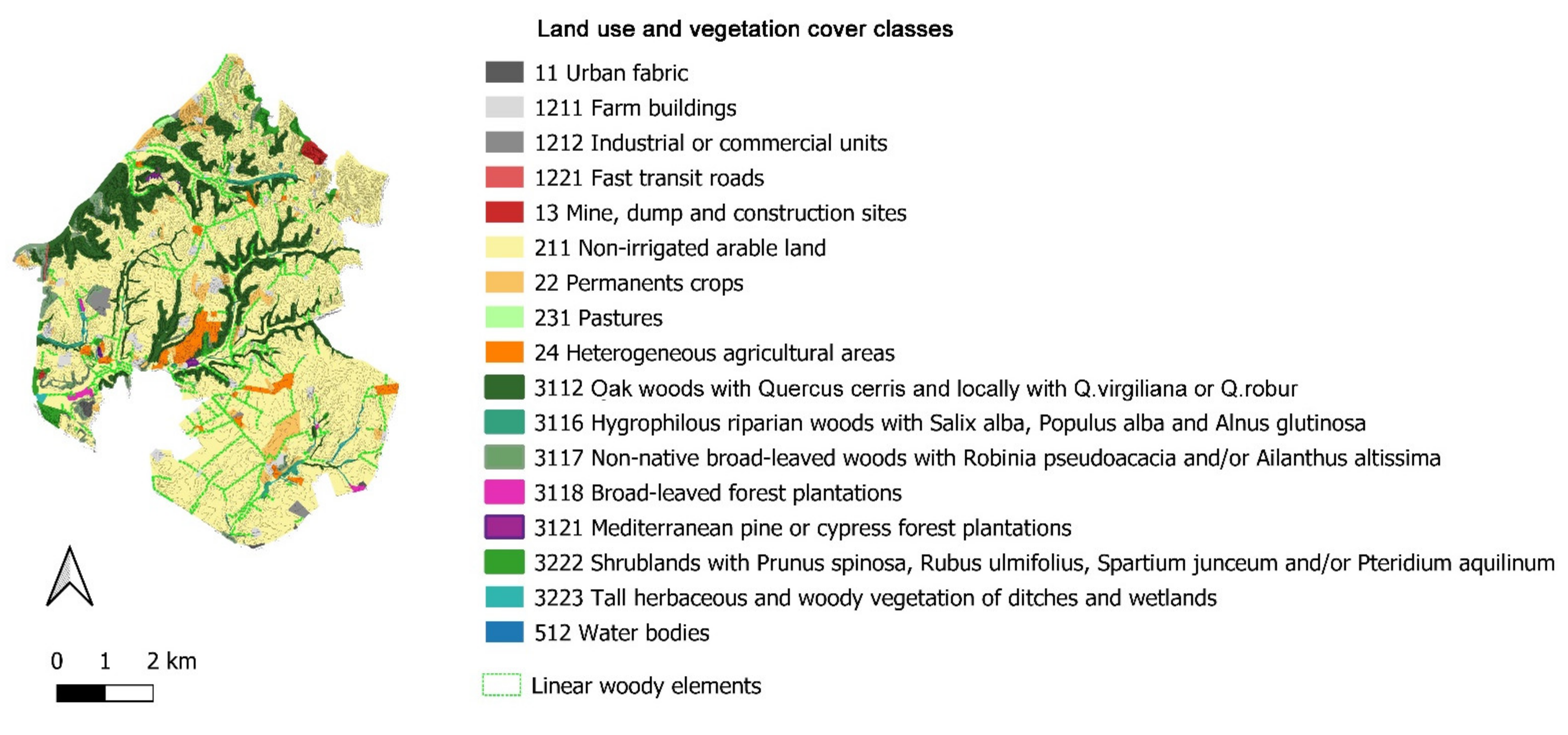
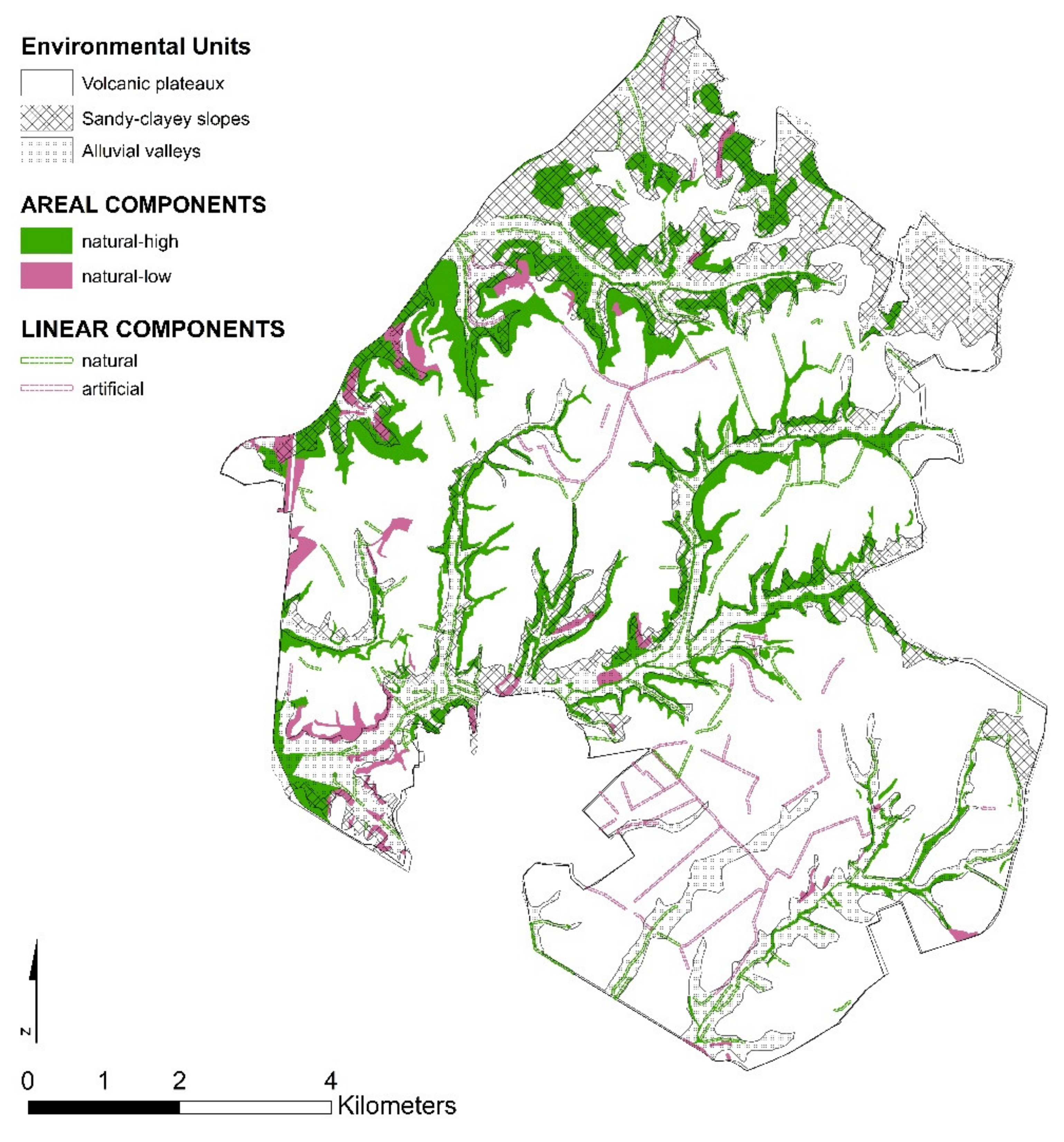
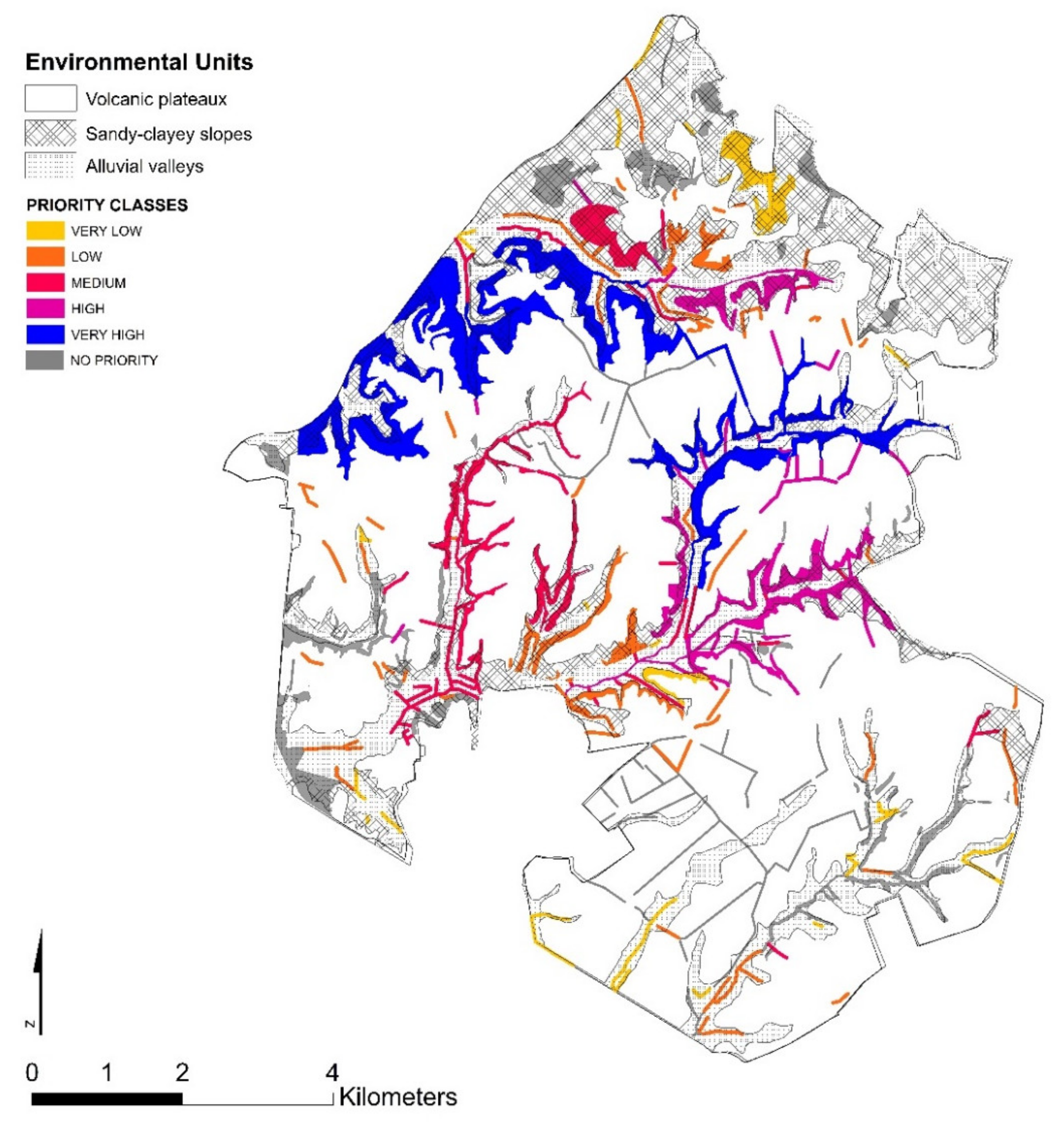
| Environmental Unit | Total Surface (ha) | Agricultural Surfaces (%) | Natural Surfaces (%) | Artificial Surfaces (%) | Density of Linear Elements (m/ha) |
|---|---|---|---|---|---|
| Volcanic Plateaux (VPL) | 2719 | 86% | 10% | 4% | 11.7 |
| Alluvial Valleys (AV) | 602 | 75% | 22% | 3% | 44.5 |
| Sandy-Clayey Slopes (SCS) | 1138 | 65% | 32% | 3% | 6.5 |
| Connectivity Feature | Level 1 (All Areal Components) | Level 2 (All Areal and Linear Components) | Level 3 (Natural-High Areal Components) | Level 4 (Natural-High Areal and Linear Components) | Level 4/VPL (Volcanic Plateaux) | Level 4/AV (Alluvial Valleys) | Level 4/SCS (Sandy-Clayey Slopes) |
|---|---|---|---|---|---|---|---|
| Number of MSPA CORES | 300 | 332 | 265 | 281 | 194 | 275 | 136 |
| Number of MSPA ISLETS | 7 | 64 | 7 | 57 | 205 | 92 | 72 |
| Number of MSPA EDGES | 179 | 200 | 146 | 168 | 192 | 239 | 180 |
| Number of MSPA LOOPS | 0 | 12 | 1 | 8 | 19 | 30 | 22 |
| Number of MSPA BRIDGES | 119 | 194 | 105 | 161 | 56 | 141 | 42 |
| Number of MSPA BRANCHES | 1132 | 1506 | 969 | 1279 | 535 | 734 | 310 |
| Number of Components (NC) | 78 | 55 | 67 | 50 | 107 | 77 | 82 |
| Integral Index of Connectivity (IIC) | 0.004 | 0.017 | 0.002 | 0.008 | 0.00083 | 0.00503 | 0.00504 |
| Conservation Priority Score | (a) Node Importance | (b) EUN Condition | (c) Link Removal | (d) Priority of the Connected Nodes | (e) Importance of Connection | (f) MSPA Class |
|---|---|---|---|---|---|---|
| 5 | dIIC > 11.57 (upper outliers) | two ‘very high’ priority nodes | ||||
| 4 | 8.74 < dIIC < 11.56 (4th quartile) | at least one ‘very high’ priority node; two ‘high’ priority nodes | ||||
| 3 | 5.05 < dIIC < 8.73 (3rd quartile) | dIIC > 13.59 (upper outliers) | at least one ‘high’ priority node; two ‘medium’ priority nodes | Bridge | ||
| 2 | 2.30 < dIIC < 5.04 (2nd quartile) | 1.30 < dIIC < 4.84 (from 1st to 4th quartile) | at least one ‘medium’ priority node | Branch | ||
| 1 | 1.53 < dIIC < 2.29 (1st quartile) | VPL | dIIC < 1.00 | two ‘low’ or ‘very low’ priority nodes | the link removal splits a component | Islet and Loop |
| Null (0) | dIIC < 1.00 | SCS; AV | the link removal does not split any component |
Publisher’s Note: MDPI stays neutral with regard to jurisdictional claims in published maps and institutional affiliations. |
© 2021 by the authors. Licensee MDPI, Basel, Switzerland. This article is an open access article distributed under the terms and conditions of the Creative Commons Attribution (CC BY) license (https://creativecommons.org/licenses/by/4.0/).
Share and Cite
Valeri, S.; Zavattero, L.; Capotorti, G. Ecological Connectivity in Agricultural Green Infrastructure: Suggested Criteria for Fine Scale Assessment and Planning. Land 2021, 10, 807. https://doi.org/10.3390/land10080807
Valeri S, Zavattero L, Capotorti G. Ecological Connectivity in Agricultural Green Infrastructure: Suggested Criteria for Fine Scale Assessment and Planning. Land. 2021; 10(8):807. https://doi.org/10.3390/land10080807
Chicago/Turabian StyleValeri, Simone, Laura Zavattero, and Giulia Capotorti. 2021. "Ecological Connectivity in Agricultural Green Infrastructure: Suggested Criteria for Fine Scale Assessment and Planning" Land 10, no. 8: 807. https://doi.org/10.3390/land10080807
APA StyleValeri, S., Zavattero, L., & Capotorti, G. (2021). Ecological Connectivity in Agricultural Green Infrastructure: Suggested Criteria for Fine Scale Assessment and Planning. Land, 10(8), 807. https://doi.org/10.3390/land10080807








